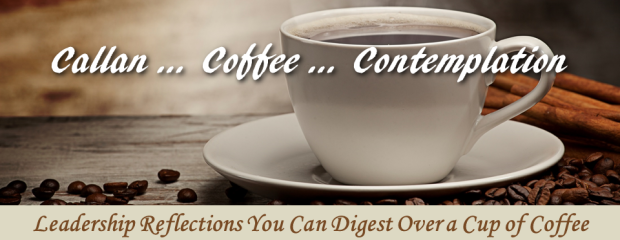Callan…Coffee…Contemplation for the Week of September 29th
The Virtue of Vigor
Vitality is a rare but oh-so-essential quality for leaders and groups alike. Vitality is one of those attributes hard to precisely define, but like other forms of excellence, you know it when you see it. And I believe vitality, as both a personal and organizational characteristic, is born of a vigorous lifestyle. By vigorous I mean heartily optimistic and physically active. I have long believed in the virtue of exercise and physical exertion because I believe a vigorous lifestyle and a vigorous body helps create and maintain a vigorous mind. I find physical activity to be the furnace producing health, hardiness, energy, zeal, enthusiasm, and endurance. And let’s be honest; what leader or group does not prize, and need, these qualities? A vital leader, modeling a vigorous lifestyle, vitalizes all. The dynamism of a vigorous leader is contagious, bolstering all in good times and in bad. In our modern world, growing increasingly sedentary and brittle, it is wise to reawaken the virtue of vigor and the necessity of a vigorous life.
Bending the Arc of History
There’s a tendency to catalogue leaders into two basic groups–either visionaries and pragmatists. That there are such basic dichotomies is true, however, great leaders, the truly significant ones, are neither just dreamers nor just doers. Great leaders are able to see a necessary future, articulate a grand aspiration, yet still summon the internal will to move the levers of influence and remain resolute in execution. Great leaders understand the criticality of balancing inspiration and perspiration; of dreaming big but executing in small, disciplined steps. This agile capability is what enables great leaders to navigate the tension between the ideal and the real, and while honoring both, they resist being dogmatic to either. Great leaders understand the power of an elevating vision—a clear sense of where we are going and why it is worth our collective sacrifice to get there. But they also understand dreams become real only when they are courageous enough, in execution, to dare bend the arc of history towards their end state.
Perennial Significance
A common question I’m asked is, “How do you define great leaders?” My answer is, perennial significance. Today, we mistakenly equate leadership excellence to success; things like rank, position, salary, perks, acclaim, etc. A truer metric for leadership greatness is perennial significance. Think of this distinction using a gardening analogy. A merely successful leader is like an annual plant–blooming and exerting influence once and during a single, tactical lifecycle. Good, yes; but no enduring impact. A significant leader is like a perennial plant–blooming year after year and influencing multiple generations in an enduring lifecycle. Examples of perennially significant leaders would be Washington, Jefferson, Lincoln, and Gandhi, to name just a few. Each was able to think globally, to understand the crucial need of their time, and yet act locally. Their residue, however, continues to bloom even to this day. The question we must therefore ask ourselves is this: What seeds of perennial excellence am I sowing for the enduring benefit of others?
Regulate
In past reflections I’ve commented on the need for leaders to regulate their own behavior through self-awareness and executive control. I believe the same is also true of groups, be they societies, companies, or teams. The degree to which a group can achieve and maintain excellence is very much a reflection on the character and quality of the group as a collective entity. The American founders understood this clearly; the ability to govern and aspire towards democratic ideals was, for better or worse, largely determined by the character, temperance, resilience and fortitude, and responsibility of the masses. This crucial point is important for us to remember today, because, as classic wisdom revealed long ago–we cannot truly legislate group behavior, we can only strive to regulate it. And how do we best regulate our groups’ behavior? Through setting and modeling high standards; establishing healthy expectations, and nurturing a deep respect for virtue and honor. And then, and most importantly—holding ourselves accountable.
Character and Conviction
Two questions I am most often asked are, “What makes a great leader?” and “Who are examples of great leaders?” These are natural questions in the study of leadership; however, the answers we often see are superficial examinations resulting in crude checklists of traits and attributes. Great leaders, I find, are often like classic Greek heroes–a paradoxical admixture of strength and weakness; genius and pragmatism; success and failure; ups and downs. But in managing these strengths and weaknesses, in navigating the labyrinth and enduring the crucible, their greatness is slowly cultivated and revealed. Therefore, I find a better approach to studying great leadership is to reflect on historical examples and do so from this prism: character and convictions. I believe we see most clearly a leader’s excellence reflected in their character and convictions born of their struggle and ultimate triumph. Who they became (inner authority and self-mastery) and to what high purposes they aspired (heroic ambition) came via the crucible, not by avoiding it. We cannot copy them, but we can understand the journey.
Check back next Monday for a round up of this week’s social media shares. Or check us out on Facebook, Twitter, Google+, or Pinterest to see our posts every day!
Tweet Share






